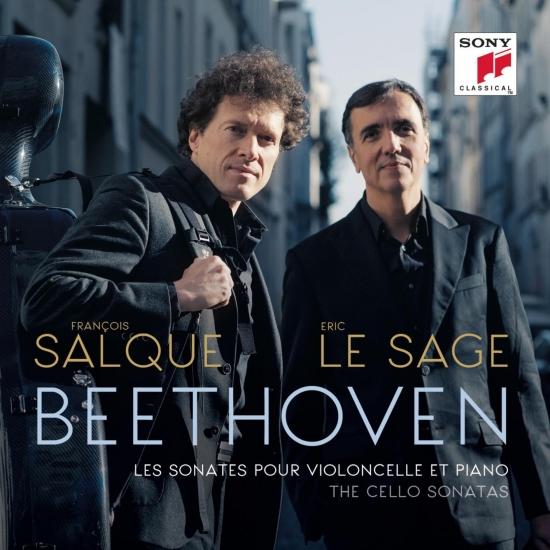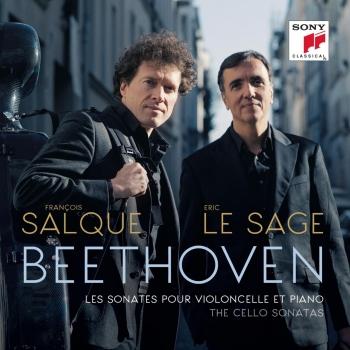
Beethoven: Sonates pour violoncelle et piano François Salque & Eric Le Sage
Album info
Album-Release:
2017
HRA-Release:
27.02.2017
Label: Sony Classical
Genre: Classical
Subgenre: Concertos
Artist: François Salque & Eric Le Sage
Composer: Ludwig van Beethoven (1770-1827)
Album including Album cover Booklet (PDF)
I`m sorry!
Dear HIGHRESAUDIO Visitor,
due to territorial constraints and also different releases dates in each country you currently can`t purchase this album. We are updating our release dates twice a week. So, please feel free to check from time-to-time, if the album is available for your country.
We suggest, that you bookmark the album and use our Short List function.
Thank you for your understanding and patience.
Yours sincerely, HIGHRESAUDIO
- Ludwig van Beethoven (1770 - 1827): Sonata No. 1 in F Major, Op. 5 No.1:
- 1Sonata No. 1 in F Major, Op. 5 No. 1: I. Adagio sostenuto - Allegro16:20
- 2Sonata No. 1 in F Major, Op. 5 No. 1: II. Rondo : Allegro vivace06:34
- Sonata No. 2 in G Minor, Op. 5 No. 2:
- 3Sonata No. 2 in G Minor, Op. 5 No. 2: I. Adagio sostenuto e espressivo - Allegro molto piu tosto presto17:54
- 4Sonata No. 2 in G Minor, Op. 5 No. 2: II. Rondo : Allegro. Allegro08:32
- Sonata No. 3 in A Major, Op. 69:
- 5Sonata No. 3 in A Major, Op. 69: I. Allegro non tanto11:58
- 6Sonata No. 3 in A Major, Op. 69: II. Scherzo : Allegro molto04:52
- 7Sonata No. 3 in A Major, Op. 69: III. Adagio cantabile - Allegro vivace07:59
- Sonata No. 4 in C Major, Op. 102 No. 1:
- 8Sonata No. 4 in C Major, Op. 102 No. 1: I. Andante07:00
- 9Sonata No. 4 in C Major, Op. 102 No. 1: II. Adagio - Allegro vivace06:55
- Sonata No. 5 in D Mjor, Op. 102 No. 2:
- 10Sonata No. 5 in D Mjor, Op. 102 No. 2: I. Allegro con brio06:21
- 11Sonata No. 5 in D Mjor, Op. 102 No. 2: II. Adagio con moto sentimento d'affecto - attaca10:19
- 12Sonata No. 5 in D Mjor, Op. 102 No. 2: III. Allegro fugato04:29
Info for Beethoven: Sonates pour violoncelle et piano
At the beginning of the nineteenth century, Beethoven was one of the first composers to reveal the expressive and technical qualities of the cello, both in his symphonic works and in his chamber music. Some illustrious predecessors (Bach, Geminiani or Vivaldi) had already worked on the creation of an autonomous repertoire of concertos and sonatas for the cello, but Beethoven transformed the former instrument of accompaniment and support of the continuo into a true partner of a music based on dialogue, exchange, and contrast.
Originating from the rebec family that had developed since the twelfth century, the cello appeared as a violin bass in Italy in the seventeenth century, then at the end of the following century its musical role was freed from the accompaniment to which it was most often confined. Until the end of the eighteenth century, its main role was limited essentially to the continuo part, realizing with the harpsichord or organ the bass lines according to the criteria of baroque aesthetics. Some composers (Vivaldi, Boccherini, Bach and Haydn), however, began to give it solo or concerto parts. In the nineteenth century, after Beethoven, many others exploited its virtuosity and specific melodic qualities, especially Schumann, Brahms, Dvorák, Lalo or Saint-Saëns... At the end of the eighteenth century, Haydn was the only one to compose real concertos for cello, but Mozart had already given it some melodic freedom in his last three Strings Quartets commissioned by the King of Prussia Friedrich-Wilhelm II, himself an amateur cellist. It is this same King of Prussia who was the dedicatee in 1796 of the two Sonatas op. 5 "for pianoforte and cello" by Beethoven. …
Éric Le Sage, piano
François Salque, cello
No biography found.











